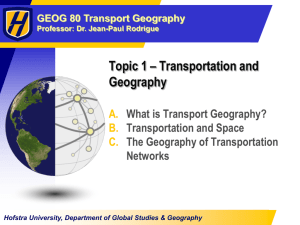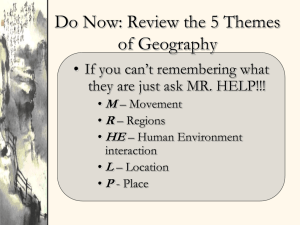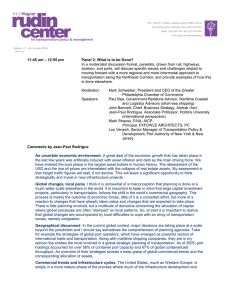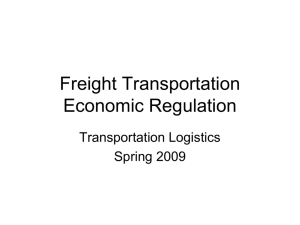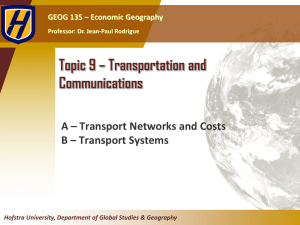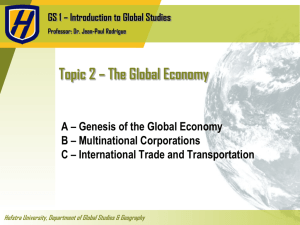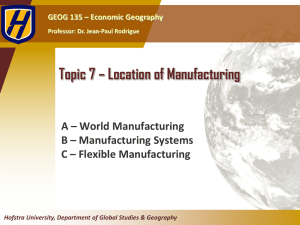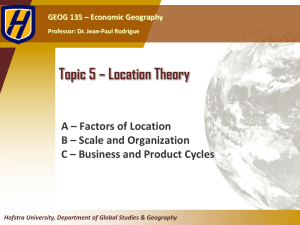Topic 2 – Transportation and the Spatial Structure
advertisement
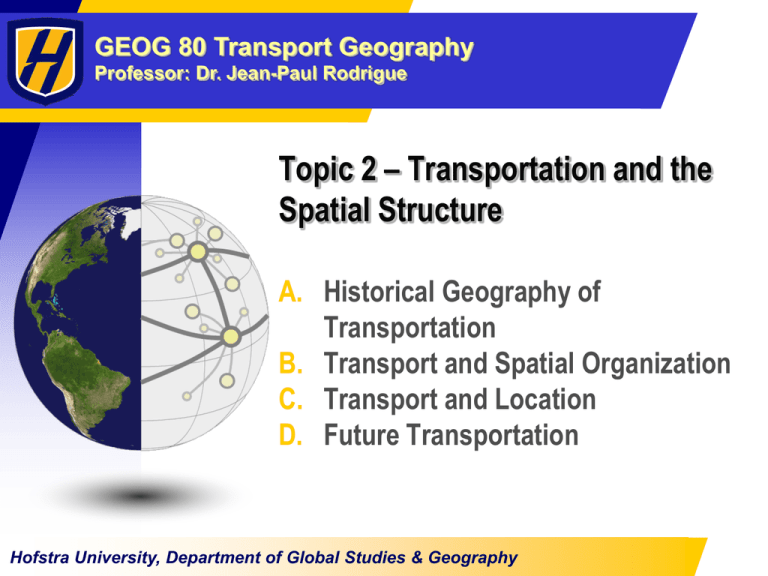
GEOG 80 Transport Geography Professor: Dr. Jean-Paul Rodrigue Topic 2 – Transportation and the Spatial Structure A. Historical Geography of Transportation B. Transport and Spatial Organization C. Transport and Location D. Future Transportation Hofstra University, Department of Global Studies & Geography A – HISTORICAL GEOGRAPHY OF TRANSPORTATION I 1. Transportation in the Pre-Industrial Era (pre 1800s) 2. The Industrial Revolution and Transportation (1800-1870) 3. Emergence of Modern Transportation Systems (1870-1920) © Dr. Jean-Paul Rodrigue Transport Revolutions in Human History Era Date Mobility Paleolithic c. 700,000 years ago First migrations from Africa c. 35,000 years ago First migrations by sea to Australasia c. 18,000 years ago First migrations to the Americas c. 4,000 BC Animal-powered transport c. 3,500 BC Wheeled transport c. 1,500 BC Long distance navigation in Polynesia c. 1,000 BC Roads and canals From 15th century Improvements in shipbuilding and navigation From early 19th century Railways and steamships From late 19th century Internal combustion engines From early 20th century Air travel From mid 20th century Space travel Agrarian Modern © Dr. Jean-Paul Rodrigue 1. Transportation in the Pre-Industrial Era (pre 1800s) ■ Limited transport technology • • • • • No mechanized forms of transportation. High friction of distance. Harnessing animal labor and wind. Isolation and limited long distance trade. Existing long distance trade: • Reliance on maritime and fluvial transportation. • High value commodities along established trade routes(e.g. Silk Road). ■ Transportation and empire building • Roman Empire (road network, 80,000 kilometers, 200 AD). • Chinese Empire (canal system, 2,500 kilometers). © Dr. Jean-Paul Rodrigue The Silk Road and Arab Sea Routes (8th to 14th Centuries) © Dr. Jean-Paul Rodrigue Roman Road Network, 200 AD Atlantic Ocean Black Sea Mediterranean Ocean 500 km © Dr. Jean-Paul Rodrigue Grand Canal System, China Beijing ■ The Grand Canal Tonghui Canal (Yuan) Yellow Sea Yongji Canal (Sui and Yuan) Old course of the Yellow River (Song) Yongji Canal (Sui) Jiao-Lai Canal (Yuan) Jizhou Canal (Yuan) Tongji Canal (Sui) East China Sea Jizhou Luoyang Kaifeng Bian Canal (Song) Huaiyin Chuzhou • Achievement of Imperial hydrological engineering. • First segments completed around 602 AD (Sui Dynasty). • At its peak during the Ming dynasty (1368-1644 AD). • Totaled about 2,500 kilometers, 1,700 still in use today. • Grain distribution through the empire, notably its capitals. Yangzhou Canal (Song and Yuan) Yangzhou Jiangnan Canal Suzhou (Sui, Song and Yuan) 400 km Hangzhou © Dr. Jean-Paul Rodrigue 1. Transportation in the Pre-Industrial Era (pre 1800s) ■ European expansion • Mastery of sailing and artillery. • Eastern trade route: • • • • Discovered by Portugal. Cape of good hope reached by 1481. Gama (1497-99) first to reach India. China reached by 1513. • Western trade route: • • • • Discovered by Columbus (1492). Failed to reach Asia (America discovered). Cabot tried (1497), but also failed. Magellan (1519-22) successful to round the world. • Establishment of colonial empires. © Dr. Jean-Paul Rodrigue Early European Maritime Expeditions, 1492-1522 © Dr. Jean-Paul Rodrigue Caravel, 15th Century © Dr. Jean-Paul Rodrigue Dutch East India Company, Trade Network, 17th Century Regional Trade Network Inbound Route to Batavia Inbound Route to Galle Return Route Galle From Silver From Precious metals Lacquer To Silk Porcelain Spices Luxury goods From To Cloth Silver Yarn Silk Indigo Pepper From To Coffee Spices Silk Amsterdam China To From Porcelain Spices Luxury goods Tea Cloth Sugar Silk Precious metals India Arabia Japan Mace To Pepper Cardamom Nutmeg Coffee Cinnamon Sugar Cloves Tea Sappanwood Galle Batavia Sri Lanka To From Cinnamon Cloth Pepper Cardamon Ivory Arecanuts Sappanwood Gems Indonesia Spice Islands Batavia From Pepper Nutmeg Mace Cloves To Cloth Silver Ivory Cape Town © Dr. Jean-Paul Rodrigue Colonial Trade Pattern, North Atlantic, 18th Century © Dr. Jean-Paul Rodrigue 2. The Industrial Revolution and Transportation (1800-1870) ■ Mechanization of transportation • Steam engine (as a water pump). • First steamship on the Delaware river (1790). • Eventually lead to the development of railways. ■ Regular maritime routes • Notably over the North Atlantic (Europe – North America). • The era of clipper ships: • Fast cargo ships used for intercontinental trade (Asia, Europe, America). • The emergence of the steamship: • Savannah (first to cross the Atlantic in 1820). • Great Britain (first steel and helix propelled ship, 1844). • Accurate navigation charts (1850s): • Prevailing winds and sea current used to the advantage of navigation. © Dr. Jean-Paul Rodrigue Clipper Ship “Flying Cloud” © Dr. Jean-Paul Rodrigue An Early Steamship, “The Great Britain”, 1845 © Dr. Jean-Paul Rodrigue Impacts of Maury’s Navigation Charts on Sailing Time, 1850s 200 187.5 Mean Sailing Days (before) Mean Sailing Days (after) 150 136 126 124 97 100 63 55 50 23 0 New York - Rio de Janeiro England - Australia Australia - England New York - San Francisco © Dr. Jean-Paul Rodrigue Break-Even Distance between Sail and Steam, 18501890 18,000 16,000 14,000 KM 12,000 10,000 8,000 6,000 4,000 2,000 0 1850 1860 1870 1880 1890 © Dr. Jean-Paul Rodrigue World Trade Routes, 1912 © Dr. Jean-Paul Rodrigue Liner Transatlantic Crossing Times, 1838 – 1952 (in days) 16 14 12 10 8 6 4 2 0 1830 1855 1880 1905 1930 1955 © Dr. Jean-Paul Rodrigue 2. The Industrial Revolution and Transportation (1800-1870) ■ Land transport systems • Serious problems of land transportation. • Roads were commonly unpaved and could not be used to effectively carry heavy loads. • Attempts to develop toll road systems (Turnpikes in UK). ■ Freight shipping canals • Bridgewater Canal, Britain (1761). • Erie Canal, New York (1825). • Linking different segments of fluvial systems into a comprehensive waterway system. • Fluvial barges. • Lowered significantly land transport costs. • Permitted initial industrialization. © Dr. Jean-Paul Rodrigue Turnpikes in Great Britain, Late 18th and Early 19th Century 35,000 30,000 25,000 Km 20,000 15,000 10,000 5,000 0 1650 1700 1750 1800 1850 © Dr. Jean-Paul Rodrigue Mail Coach, Great Britain, 18th Century © Dr. Jean-Paul Rodrigue Bridgewater Canal, Manchester, 1767 © Dr. Jean-Paul Rodrigue Erie Canal, New York, 1829 © Dr. Jean-Paul Rodrigue 2. The Industrial Revolution and Transportation (1800-1870) ■ Railway systems • First commercial rail line in 1830 (Manchester-Liverpool; 40 miles). • Access to national resources and markets: • The triumph of inland transportation. • First urban systems. • End of the canal era: • Many canals fell into disrepair. • Unable to compete with the speed and flexibility of rail. • Only the most strategic links were kept. • From a point-to-point to an integrated rail system: • Large companies. • Standard gauge. • Standard times zones (1884) © Dr. Jean-Paul Rodrigue Completion of the Transcontinental Railway, 1869 © Dr. Jean-Paul Rodrigue 3. Emergence of Modern Transportation Systems (1870-1920) ■ Growth of international transportation • Shift from coal to oil in ships: • Reduce their energy consumption by a factor of 90%. • Increase in ship size (no longer limited by wood). • Construction of the Suez and Panama canals. ■ Dominance of the rail transport system • By the early 20th century, most systems reached their peak. • Overinvestment and over development. • A phase of decline then began. © Dr. Jean-Paul Rodrigue Rail Track Mileage, United States, 1833-2006 300,000 250,000 Miles of tracks 200,000 150,000 100,000 50,000 0 1830 1850 1870 1890 1910 1930 1950 1970 1990 2010 © Dr. Jean-Paul Rodrigue Geographical Impacts of the Suez and Panama Canals © Dr. Jean-Paul Rodrigue Effects of the Suez and Panama Canals on Travel Distances (in nautical miles) New York - Sydney Liverpool - San Francisco New York - San Francisco London - Singapore London - Bombay 0 via Panama Canal 2,000 4,000 via Magellan Straits 6,000 8,000 via Suez Canal 10,000 12,000 14,000 via Cape of Good Hope © Dr. Jean-Paul Rodrigue 3. Emergence of Modern Transportation Systems (1870-1920) ■ Modern urban transportation • • • • • Increase in urban population. Introduction of tramways (1880; horse drawn, and then electric). Urban sprawl and the specialization of economic functions. Underground metro systems in large cities (London, 1863). Bicycle (1867); cheap mobility for the masses. ■ Modern telecommunications • • • • • Telegraph (1844). Associated with the growth of railways and international shipping. Business transactions became more efficient. Creation of standard times zones (1884). Every continent was linked by telegraphic lines (1895). © Dr. Jean-Paul Rodrigue Global Telegraph System, c1901 (the Victorian Internet) © Dr. Jean-Paul Rodrigue A – HISTORICAL EVOLUTION OF TRANSPORTATION II 1. Transportation in the Fordist Era (1920-1970) 2. A New Context for Transportation : the Post-Fordist Era (1970-) © Dr. Jean-Paul Rodrigue 1. Transportation in the Fordist Era (1920-1970) ■ Internal combustion engine • Diesel engine (1885). • Extended flexibility of movements. • Fast, inexpensive and ubiquitous transport modes (cars, buses and truck). ■ Mass production system • Applied by Ford for car manufacturing. • Ford Model T: about 14 million Ford Model T were built (19131927). • Increased demand for oil products and other raw materials (steel and rubber). © Dr. Jean-Paul Rodrigue Assembly Line of the Ford Model T, 1913 © Dr. Jean-Paul Rodrigue Ford T Coupelet, 1915 © Dr. Jean-Paul Rodrigue $1,000 2.25 $900 2.00 $800 1.75 $700 Millions Cost and Production of Ford Vehicles, 1908-1924 1.50 $600 1.25 $500 1.00 $400 Cost $300 Production 0.75 $200 0.50 $100 0.25 $0 0.00 © Dr. Jean-Paul Rodrigue 1. Transportation in the Fordist Era (1920-1970) ■ Economies of scale • Mass consumption of resources. • Bulk commodities such as minerals and grain over long distances. • Oil Tankers. ■ Propelled flight • Wright brothers (1903). • Commercial air transport service between England and France (1919). • Expansion of regional / national air transport services (1920s1930s). • Douglas DC-3 (1935). • First commercial jet plane (Boeing 707; 1958). © Dr. Jean-Paul Rodrigue Comparison between a Contemporary and Second World War Tanker Modern VLCC (305 m) 1975 T2 Tanker (153 m) 1942 © Dr. Jean-Paul Rodrigue ULCC, Persian Gulf © Dr. Jean-Paul Rodrigue Wright Brothers First Airplane, 1903 © Dr. Jean-Paul Rodrigue Douglas DC-3, 1937 © Dr. Jean-Paul Rodrigue Boeing 707, 1958 © Dr. Jean-Paul Rodrigue 1. Transportation in the Fordist Era (1920-1970) ■ Telecommunications • Mass market media. • Telephone (1878). • Radio (1920): • First radio shows: to sell radios. • Television (1950). ■ Automobile • Massive diffusion (1950s). • Greater customization of vehicles. • Suburbanization and expansion of cities. © Dr. Jean-Paul Rodrigue 2. A New Context for Transportation : the PostFordist Era (1970-) ■ Telecommunications • Merging with information technologies. • Information highway (Internet). • Growth in processing power of computers: • Moore’s law. • Number of transistors per integrated circuit would double every 18 months. • Satellite communications. • Wireless networks. © Dr. Jean-Paul Rodrigue Moore’s Law: Transistors per Microprocessor, 1971-2008 1,000,000,000 100,000,000 10,000,000 1,000,000 100,000 10,000 1,000 1970 1975 1980 1985 1990 1995 2000 2005 2010 © Dr. Jean-Paul Rodrigue US Household Penetration of Telecommunications, 1920-2008 100 90 % of Households 80 70 60 50 40 30 20 10 0 1920 1930 1940 1950 1960 1970 Radio TV Cable VHS Satellite TV 1980 1990 DVD 2000 2010 Broadband © Dr. Jean-Paul Rodrigue 2. A New Context for Transportation : the PostFordist Era (1970-) ■ Globalization of trade • • • • Fragmentation of the production. International division of labor. The principle of “just-in-time”. Development of logistics. ■ Containerization • Increased flexibility of freight transport. • First containership, Ideal-X (1956). • Cellular containerships (1967). ■ Massification of air transport • Boeing 747 (1969). © Dr. Jean-Paul Rodrigue Cellular Containership, La Havre, France © Dr. Jean-Paul Rodrigue Boeing 747 © Dr. Jean-Paul Rodrigue Some Costs of Long Distance Travel Link Cost in Dollars (Current 2005 Dollars) Transatlantic steamship (1880s) $35 to $100 ($1,000 to $3,000) Transcontinental rail (1880s) $100 to $200 ($3,000 to $6,000) Transcontinental rail (1940s) $70 to $100 ($250 to $350) Transcontinental air (1940s) $300 ($3,600) Transcontinental air (1960s) $150 ($1,200) Transcontinental air (2000s) $600 © Dr. Jean-Paul Rodrigue 2. A New Context for Transportation : the PostFordist Era (1970-) ■ High-speed train networks • Shinkansen, Japan (1964). • TGV, France (1981). ■ Globalization of car manufacturing • Three major players, US, Germany and Japan. • New producers (Korea). • 80% of oil consumption attributed to road transportation. ■ Growing transport constraints • Innovations in transport modes. • Reduction of energy consumption. • Alternative sources of energy. © Dr. Jean-Paul Rodrigue Shinkansen, Japan © Dr. Jean-Paul Rodrigue Automobile Production, Selected Countries,19502008 (in millions) 55 50 China Germany 45 40 Japan United States World 35 30 25 20 15 10 5 0 © Dr. Jean-Paul Rodrigue
